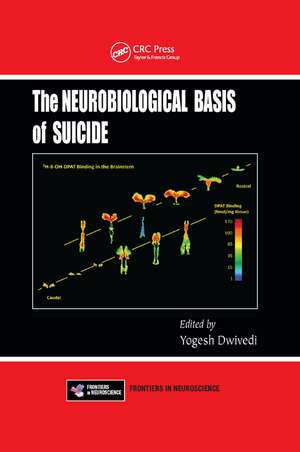The Neurobiological Basis of Suicide
Editat de Yogesh Dwivedien Limba Engleză Paperback – 19 sep 2019
Psychological, psychosocial, and cultural factors are important in determining the risk factors for suicide; however, they offer weak prediction and can be of little clinical use. Interestingly, cognitive characteristics are different among depressed suicidal and depressed nonsuicidal subjects, and could be involved in the development of suicidal behavior.
The characterization of the neurobiological basis of suicide is in delineating the risk factors associated with suicide. The Neurobiological Basis of Suicide focuses on how and why these neurobiological factors are crucial in the pathogenic mechanisms of suicidal behavior and how these findings can be transformed into potential therapeutic applications.
| Toate formatele și edițiile | Preț | Express |
|---|---|---|
| Paperback (1) | 500.35 lei 6-8 săpt. | |
| CRC Press – 19 sep 2019 | 500.35 lei 6-8 săpt. | |
| Hardback (1) | 993.02 lei 6-8 săpt. | |
| CRC Press – 25 iun 2012 | 993.02 lei 6-8 săpt. |
Preț: 500.35 lei
Preț vechi: 588.64 lei
-15% Nou
Puncte Express: 751
Preț estimativ în valută:
95.75€ • 98.93$ • 79.65£
95.75€ • 98.93$ • 79.65£
Carte tipărită la comandă
Livrare economică 19 martie-02 aprilie
Preluare comenzi: 021 569.72.76
Specificații
ISBN-13: 9780367381196
ISBN-10: 0367381192
Pagini: 482
Dimensiuni: 156 x 234 x 25 mm
Greutate: 0.76 kg
Ediția:1
Editura: CRC Press
Colecția CRC Press
ISBN-10: 0367381192
Pagini: 482
Dimensiuni: 156 x 234 x 25 mm
Greutate: 0.76 kg
Ediția:1
Editura: CRC Press
Colecția CRC Press
Public țintă
Professional ReferenceCuprins
Diagnosis, Traits, States, and Comorbidity in Suicide. Neuroanatomy of Serotonergic Abnormalities in Suicide. Noradrenergic Dysfunction in Depression and Suicide. Gamma-Aminobutyric Acid Involvement in Depressive Illness: Interactions with Corticotropin-Releasing Hormone and Serotonin. Role of the Endocannabinoid System in the Neurobiology of Suicide. Stress–Diathesis Model of Suicidal Behavior. Do Serum Cholesterol Values and DST Results Comprise Independent Risk Factors for Suicide? Brain-Derived Neurotrophic Factor in Suicide Pathophysiology. Neuroimaging: High Risk States for Suicide. Gene–Environment Interaction and Suicidal Behavior. Genetic Factors and Suicidal Behavior. Approaches and Findings from Gene Expression Profiling Studies of Suicide. Epigenetic Effects of Childhood Adversity in the Brain and Suicide Risk. Genetics of Suicidal Behavior in Children and Adolescents. Neurobiology of Teenage Suicide. Suicidal Behavior in Pediatric Population: Neurobiology and the Missing Links in Assessing Risk among Patients with Bipolar Disorder. Suicide in Late Life. Intermediate Phenotypes in Suicidal Behavior: Focus on Personality. Toxoplasma gondii, the Immune System, and Suicidal Behavior. Peripheral Biomarkers for Suicide. Medication in Suicide Prevention: Insights from Neurobiology of Suicidal Behavior.
Notă biografică
Yogesh Dwivedi is with the Department of Psychiatry at the University of Illinois.
Descriere
Psychological, psychosocial, and cultural factors are important in determining the risk factors for suicide; however, they offer weak prediction and can be of less clinical value. With recent studies using genetic, epigenetic, and other molecular and neurochemical approaches, a new era has begun in understanding the suicide pathophysiology. This volume discusses how and why neurobiological factors are crucial in understanding the pathogenic mechanisms of suicidal behavior and how these findings can be transformed into potential therapeutic applications.








